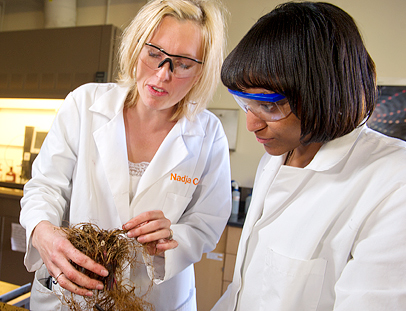News & Events
Natural Science
Posted on February 3, 2016

Growing up, Dr. Nadja Cech was always around herbs on her family’s farm. Lavender.Echinacea. Comfrey. Calendula. Black cohosh.
Through the years, she heard the lore. Use this one as an antiseptic. That one to prevent colds. Make a poultice with that to reduce inflammation.
Now, as a chemistry professor, her research agenda focuses on herbs and their medicinal properties.
“We’re taking a look at plants with a long history of use by American Indians or in Traditional Chinese and Ayurvedic medicine,” Cech says. “Our major goal is to figure out if these traditional treatments work and how. We’re trying to see which health claims are substantiated and develop ways to use plants more effectively for medicine.”
People say the reason herbal medicines work is because of synergy, when two things combined equal something greater.
To do that, she and a group of students and fellow scientists employ mass spectrometry, which is an analytical technique that measures molecular mass, and various biological experiments to examine the interplay of the multiple, diverse compounds that are contained in a given herb.
“People say the reason herbal medicines work is because of synergy, when two things combined equal something greater,” she says. “That’s what our lab focuses on, comparing the activities of mixtures versus single compounds.”
While she has studied a variety of herbs, a large part of Cech’s work has focused onEchinacea and goldenseal.
“Echinacea is traditionally used for its effects on the immune system, but what these effects are is the subject of debate,” she says. “Some think Echinacea prevents infection by stimulating the immune system; others think it protects the body from the inflammation that is caused by viruses.”
The goal of research in the Cech lab, which is currently funded by the National Institutes of Health, is to develop particular Echinacea preparations with specific mixtures of compounds that are effective at suppressing inflammation.
One surprising finding of this research is that bacteria that live within Echinacea plants might play a key role in its effectiveness.
“It seems that the bacteria living in Echinacea stimulate the immune response, which could prevent infection. Chemicals produced by the plant itself may be effective at suppressing inflammation.”
Goldenseal, a plant native to North Carolina, also has a great deal of therapeutic potential. It has traditionally been used as a topical treatment for infection. One possible use could be treatment or prevention of staph infections such as MRSA, which cause more deaths each year in the US than HIV/AIDS.
“With goldenseal we’re looking at four different molecules that play a role in antibacterial activity, and I think a dozen or more (molecules) are important,” Cech says. “Resistance to current treatments is on the rise, and there are not a lot of good new drugs in the pipeline. It’s not something that has been the focus of pharmaceutical companies in the recent past. That’s why it’s important for academics to work on this problem.”





